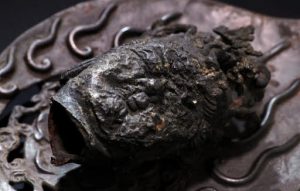Silent Witness: Buddhist statue with melted face
Jan. 21, 2019
by Yumi Kanazaki, Staff Writer
Statue conveys horror of the fierce A-bomb fire
The head and torso of the Buddhist statue, made of iron, are kept as separate items in the storage room of the Hiroshima Peace Memorial Museum. The head and halo, detached from the torso, is 29 centimeters high. Its face, which melted in the searing heat of the atomic bombing and is seemingly covered in burn blisters, epitomizes the fierce fire which engulfed Hiroshima in the aftermath of the blast. The statue conveys the fact that scores of people suffered similar burns.
According to the Peace Memorial Museum, Yoshio Karatsu, who lived in Hiranomachi (part of present-day Naka Ward), placed the Buddhist statue in an alcove of his home after the war. His original house, located 1.7 kilometers from the hypocenter, was burned to the ground. Mr. Karatsu had four sons, and his second son, who was helping to create a fire lane by dismantling homes close to the hypocenter, and his fourth son, who was on his way to school, perished in the A-bomb attack.
About two months after the bombing, Mr. Karatsu and his first son, Mikio, dug the statue out of the rubble at the remains of his house. However, the statue was broken at the neck, so Mr. Karatsu joined the head and torso together with pieces of wood and cherished the statue as a memento of his lost sons.
After Mr. Karatsu, the original owner of the statue, passed away, his son Mikio continued to care for it. Following the 17th anniversary of his father’s death, Mikio donated the statue to the Peace Memorial Museum.
Mikio passed away in 2013 at the age of 85. Before he died, he said that his father would have been happy to know that the statue was now at the Peace Memorial Museum, where it can remind visitors of the importance of peace. It is as if the Buddhist statue is telling us that the grief and sorrow of all the parents who lost their beloved children to the atomic bomb should be passed on to future generations.
(Originally published on January 21, 2019)
Statue conveys horror of the fierce A-bomb fire
The head and torso of the Buddhist statue, made of iron, are kept as separate items in the storage room of the Hiroshima Peace Memorial Museum. The head and halo, detached from the torso, is 29 centimeters high. Its face, which melted in the searing heat of the atomic bombing and is seemingly covered in burn blisters, epitomizes the fierce fire which engulfed Hiroshima in the aftermath of the blast. The statue conveys the fact that scores of people suffered similar burns.
According to the Peace Memorial Museum, Yoshio Karatsu, who lived in Hiranomachi (part of present-day Naka Ward), placed the Buddhist statue in an alcove of his home after the war. His original house, located 1.7 kilometers from the hypocenter, was burned to the ground. Mr. Karatsu had four sons, and his second son, who was helping to create a fire lane by dismantling homes close to the hypocenter, and his fourth son, who was on his way to school, perished in the A-bomb attack.
About two months after the bombing, Mr. Karatsu and his first son, Mikio, dug the statue out of the rubble at the remains of his house. However, the statue was broken at the neck, so Mr. Karatsu joined the head and torso together with pieces of wood and cherished the statue as a memento of his lost sons.
After Mr. Karatsu, the original owner of the statue, passed away, his son Mikio continued to care for it. Following the 17th anniversary of his father’s death, Mikio donated the statue to the Peace Memorial Museum.
Mikio passed away in 2013 at the age of 85. Before he died, he said that his father would have been happy to know that the statue was now at the Peace Memorial Museum, where it can remind visitors of the importance of peace. It is as if the Buddhist statue is telling us that the grief and sorrow of all the parents who lost their beloved children to the atomic bomb should be passed on to future generations.
(Originally published on January 21, 2019)








